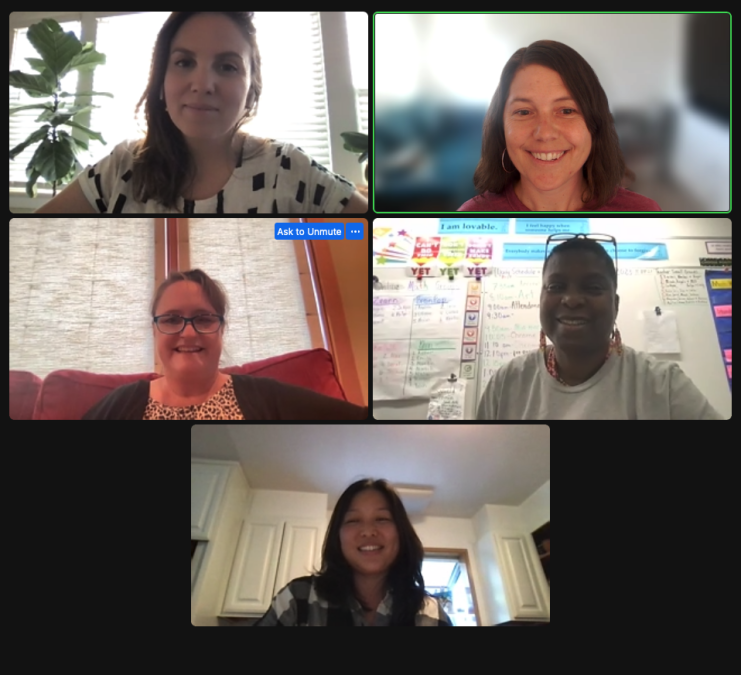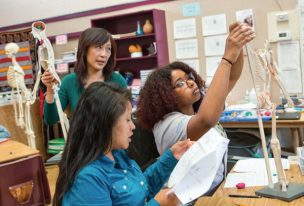
Design Teams: A Strategy for Developing Distributive Leadership Through Adult Learning Design
More often than not, adult learning is planned in isolation by a single leader who is left to assume what the adults in their system need to improve. In taking this approach, an opportunity to develop distributive leadership and partnership is missed. Design Teams offer an alternative approach to designing adult learning, one where those receiving the learning are at the table with leaders. By bringing together a vertical slice of the system and celebrating the unique perspective, expertise, and priorities of each individual’s role, a leader can empower their team to collectively problem-solve for continual improvement. The practice is designed for leaders who are willing and ready to share power and distribute leadership through adult learning.
Jeannette McNeil is one of those leaders. She has been a principal at Monroe Elementary School in San Leandro for the past 13 years. She has always taken a collaborative approach to school leadership but decided to take the approach further by inviting 5 members of her Leadership Team to be on her Design Team with Lead by Learning. The Monroe Design Team has partnered with Lead by Learning for the past two years in our ILT Network space and has seen the impact in both student and adult learning.
To support the Monroe Design Team’s success, Lead by Learning worked hand in hand with their team to take the following 5 steps to get started.
Step 1: Select one adult learning space to be the focus of your Design Team.
At first, Monroe considered thinking about their grade-level meetings, but after an initial Design Team meeting, they agreed that a first step was to center the importance on increasing comfort, and ultimately engagement levels, with the entire staff to eventually trickle into greater comfort at looking at student work during the grade-level time. Monroe chose to focus on their Whole Staff Professional Development space because they felt that it was often underutilized and they noticed that often the same staff members were contributing, but they were not consistently hearing from other staff members. Now with this as a focused space, the Design Team was ready to begin their inquiry.
Step 2: Think about who should join the Design Team to ensure diverse perspectives are heard.
Jeannette selected a range of perspectives from multiple grade levels, as well as from different levels of teaching experience and years at Monroe. She wanted to ensure this new team could both build on their historical knowledge of teacher dynamics and also think of new ways to engage the entire staff.
Step 3: Reflect on the mindsets the School Leader would bring to the space.
For many systems, a Design Team is new. Teachers are not used to being invited to the table to robustly collaborate and leaders can often fall back on old habits of planning alone. Therefore, careful thought and planning as to how the leader wants to be in the space concerning positionality and power is important. During initial meetings to plan the space, Jeannette talked a lot about how she wanted to both ensure her team knew her stances on issues and also make space for others to feel safe to share their own if they didn’t align.
One of these stances was her stance against racism and inequity. She expressed early on that her hard line to disrupt inequity might be making others at her site feel that there was no room to share or discuss ideas or beliefs that might not be the same as hers. She realized that it would be important for her in both the Design Team and in the Whole Staff space to take a step back to make room for others to step up and feel safe enough to share their thoughts and questions so that as a school site they could support each other’s growth in this area and self-awareness. This was an important reflection for her to have on current power dynamics and positionality. She realized that to partner with her Instructional Leaders, she needed to play more of a listening role during our meetings and as the year continued she was eventually absent from the small groups that were formed during whole staff collaboration time so that teachers could share freely with each other. The Design Team members who facilitated those conversations would share anonymous notes from their conversations with their peers to highlight themes and trends during the Design Team space to honor this important mindset and power shift for them to reach their goals and also ensure they were listening objectively to the data.
Step 4: Think about what data and questions will support a rich, collaborative conversation.
To reach their goals and know if they were meeting them throughout the year, Jeannette and her team started by looking at student data but quickly realized they also needed adult learning data. Part of the reason why they were seeing the same data year after year for students was likely because they weren’t talking about the inequities honestly or making concrete changes to their teaching practices and mindsets as adult learners to address those inequities. In order to do that, they needed to be able to have honest and open conversations. The Design Team then started collecting data from their teachers to understand more about their experiences during staff collaboration times.
They started with a winter teacher survey that asked a range of questions in hopes of understanding their level of comfort participating during whole staff meetings, as well as if they believed that the staff as a whole spends time questioning biases or assumptions that are getting in the way of equitably serving all students. Based on this data, the team had discussions about the next steps, which ultimately led to the creation of the smaller Investigation Groups. These smaller groups became a very successful strategy to address their initial concerns, as measured by a second staff survey that they administered towards the end of the year. In addition to the staff surveys, the Design Team members also paid close attention to staff participation during whole staff collaboration, and eventually the Investigation Groups. At Design Team meetings both the survey data and the observation were discussed during the Design Team meetings.
Step 5: Consider when and where these meetings should take place to create the conditions for success.
While this might seem small, ensuring that the Design Team is at the right time for all members to attend and in a space that is accessible and safe is important.
Monroe decided to meet once a month after school over Zoom. Each team is of course different and some take a hybrid approach or prefer to meet in person.
Building Momentum for Future School Years
After one of our final Design Team meetings of the 23-24 school year, Jeannette reflected back on her experience as a site leader to distribute leadership.
She shared that she felt proud of the work of the Design Team and was impressed with how everything happened organically.
As a leader, she learned that she doesn’t have to always be the one to facilitate the whole staff collaboration space and how much she can learn from her teacher leaders when they facilitate and share their reflections and realizations with her afterward.
And most importantly she felt excited and ready for next year. The shift to the smaller Investigation Groups that her Design Team made not only increased engagement but also brought a new model of collaboration to her site.
Design Teams can have a huge impact on school leadership. As a school leader, we invite you at Lead by Learning to no longer create adult learning experiences for your staff in a vacuum. Instead, harness the power of important members of your team to reimagine what adult learning and collaboration can look like at your school site. If we can do that, we can transform the student experience at your site as well. Get started with our Design Team practice, using our Design Team Step into Practice tool.
Interested in working with Lead by Learning to support professional learning for your educator and site leaders? Connect with a member of our team to learn more about our partnerships.

